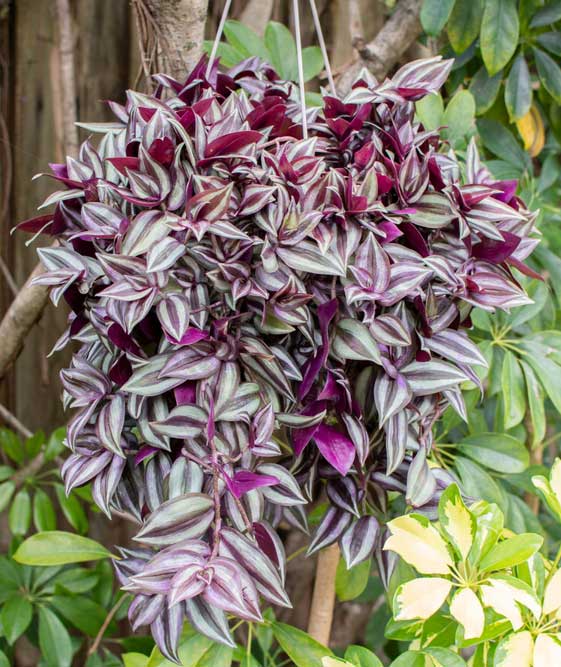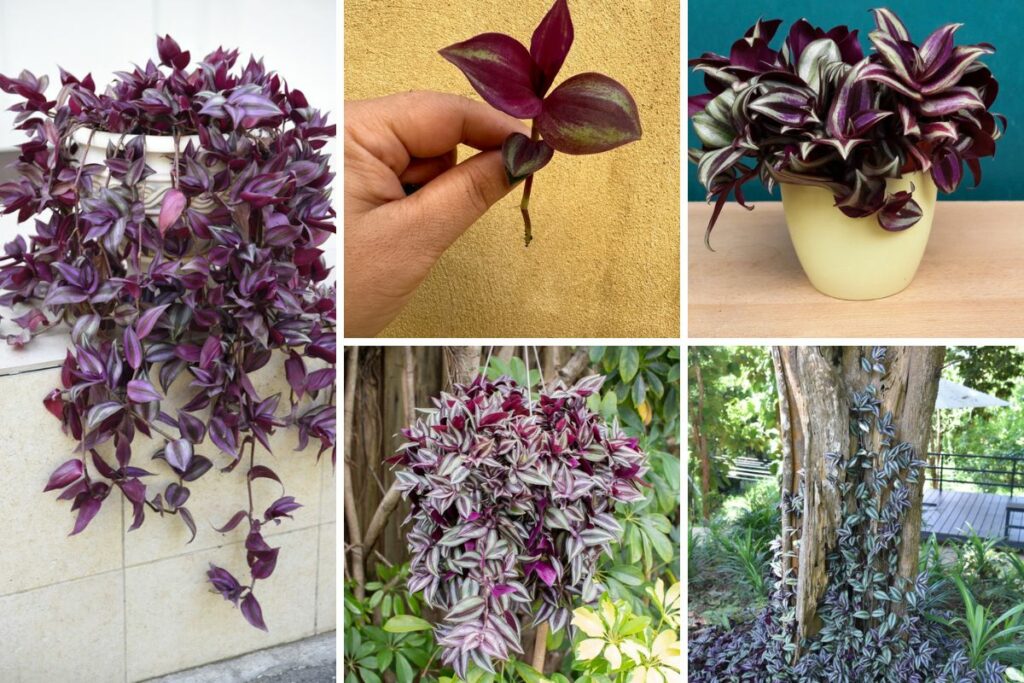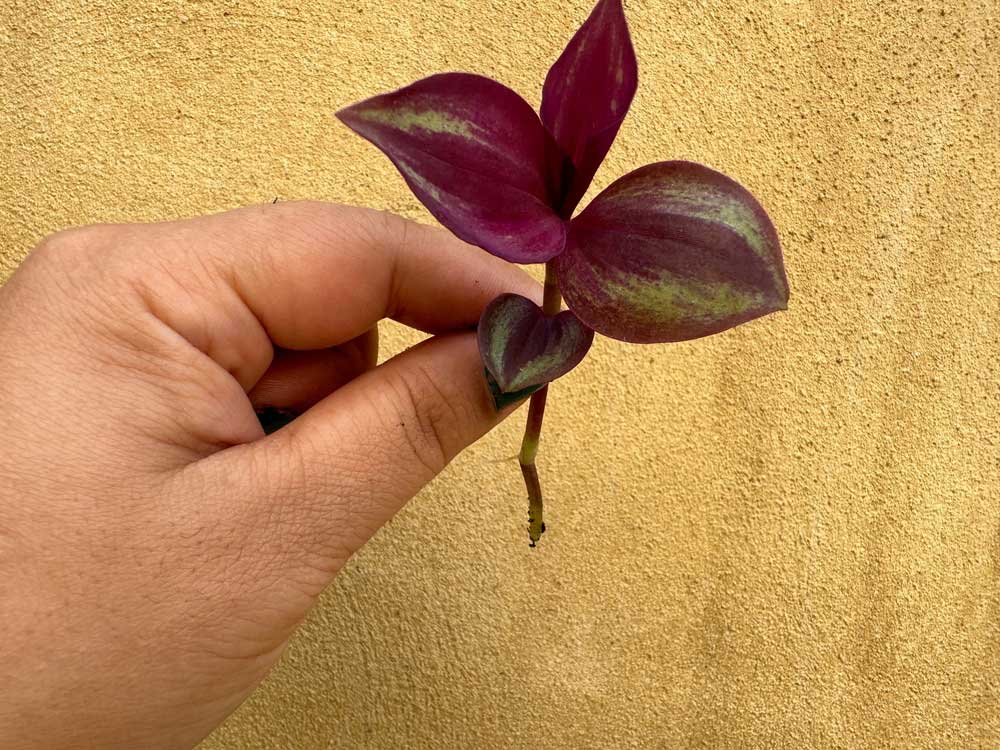Tradescantia zebrina, commonly known as the wandering jew or inch plant, is a fast-growing perennial that is prized for its striking foliage with purple and silver stripes.
This lush vining plant is incredibly adaptable, making it an ideal choice for both beginners and experienced gardeners looking to add a touch of vibrant greenery to their indoor spaces or shaded garden areas.
With its ability to thrive in a variety of conditions, learning how to cultivate Tradescantia zebrina can be both rewarding and enjoyable.

Creating the right environment for your Tradescantia zebrina is key to its growth. This plant prefers bright, indirect light but can also tolerate low-light conditions, making it versatile for different lighting scenarios in your home.
Proper watering is essential; the soil should be kept moist but not waterlogged to prevent root rot. Ensuring good drainage will help maintain the right moisture balance. Fertilizing every month during the growing season can encourage lush foliage and help your plant flourish.
Aside from light and water, providing your Tradescantia zebrina with the correct temperature and humidity levels will contribute significantly to its well-being.
This tropical plant enjoys a warm environment and appreciates a boost in humidity, which can be achieved through regular misting or by placing a tray of water near the plant.
Pinching back the stems can promote a bushier growth habit and prevent it from becoming leggy. With these simple care tips, your Tradescantia zebrina can become a stunning feature in your plant collection.
Understanding Tradescantia Zebrina
Tradescantia Zebrina, also known as the Wandering Jew or Inch Plant, is a fast-growing perennial with striking foliage.
Let’s dive into the specifics of this species and the benefits it brings to your home or garden.
Species Overview
Scientific Name: Tradescantia zebrina
Family: Commelinaceae
Origin: Native to Mexico and Central America
Tradescantia zebrina is characterized by its zebra-patterned leaves, which are glossy and have purple undersides. The leaves grow on succulent stems that can trail or hang, making this species ideal for containers or as ground cover.
It thrives in humidity and does well with indirect light. The plant is hardy in USDA zones 8-12 and can be grown as an annual or indoors in cooler climates. Regular watering and well-draining soil are key, but be wary of overwatering to prevent root rot.
Benefits and Uses
Air Purification: Tradescantia Zebrina has been shown to remove volatile organic compounds from indoor air, contributing to a healthier environment.
Decorative Appeal: With its distinctive leaves and trailing growth, it makes an excellent choice for hanging baskets or elevated planters.
Not only does the plant add a lively splash of green and purple to your space, but it’s also incredibly easy to propagate. Small cuttings can be placed in water or directly into the soil, where they quickly take root and grow. This ease of propagation makes Tradescantia Zebrina a generous plant, perfect for sharing with friends and fellow plant enthusiasts.
Cultivating Conditions

Creating the ideal environment for your Tradescantia Zebrina is essential for vibrant growth and coloration. Understanding the specifics of light, water, soil, and climate will help you cultivate a thriving plant.
Light Requirements
Your Tradescantia Zebrina loves bright, indirect sunlight. Aim to provide it with plenty of light without exposing it to the harsh midday sun which can scorch the leaves. A spot near an east or west-facing window is ideal. If natural light is limited, consider using a grow light to supplement.
Watering Needs
Consistent watering keeps your plant healthy, but overwatering can lead to root rot. Water your Zebrina when the top inch of soil feels dry. Here is a simple schedule:
- Spring to Summer: Water every week.
- Fall to Winter: Water less frequently, every 10-14 days.
Soil and Fertilization
A well-draining soil mix is crucial to prevent water from pooling around the roots. Mix two parts peat moss with one part perlite for optimal drainage. Fertilize your Zebrina monthly during the growing season (spring to early fall) with a balanced, water-soluble fertilizer diluted to half the recommended strength.
Temperature and Humidity
Your Tradescantia Zebrina thrives in warm conditions with high humidity. Aim to keep the temperature around 65-75°F (18-24°C). Boost humidity by:
- Misting: Lightly mist the leaves.
- Tray with Pebbles: Place the pot on a tray filled with water and pebbles.
- Humidifier: Use a room humidifier if needed.
Keep your Tradescantia away from drafts and sudden temperature changes to maintain its health.

Planting and Propagation
Tradescantia Zebrina, commonly known as inch plant or wandering jew, is very easy to propagate and plant. The methods are simple and rooting takes place effectively if you follow the steps correctly.
Propagation Methods
To successfully propagate your Tradescantia Zebrina, you can use either stem cuttings or division.
- Stem Cuttings:
- Cut: Select a healthy stem and cut a 4-6 inch piece just below a node.
- Remove Leaves: Strip the leaves from the bottom 2 inches of the cutting.
- Rooting Medium: Place the cutting in a jar of water or a moist potting mix.
- Light: Position the cutting in indirect sunlight and change the water every few days if rooting in water.
- Division:
- Remove Plant: Gently take the parent plant out of its pot.
- Separate: Identify natural divisions and carefully tease the roots apart.
- Replant: Pot each division in its own container with fresh potting soil.
Planting Steps
Once your Tradescantia Zebrina cuttings have rooted, it’s time to plant them.
- Select a Pot: Choose a pot with drainage holes and fill it partially with potting soil.
- Plant the Cutting: Make a small hole in the soil and insert the rooted cutting or division.
- Soil: Gently pack the soil around the base of the plant.
- Water: Thoroughly water the plant and let the excess drain out.
Remember to keep the soil moist but not soggy, and place your new plant in bright, indirect light.
Ongoing Care and Maintenance
To keep your Tradescantia Zebrina healthy and vibrant, regular pruning and vigilance against pests and diseases are crucial.
Pruning Techniques
Your Tradescantia Zebrina benefits greatly from routine pruning. Pinching back the stem tips every few weeks encourages bushier growth and prevents legginess. Using clean, sharp scissors or fingernails, snip off the top one to two inches of the plant. Be sure to cut just above a leaf node, as new growth will emerge from this point.
- Identify long, leggy stems.
- Pinch or cut these stems back to the desired length.
- Remove any yellow or dead leaves to keep the plant looking tidy.
Pest and Disease Management
Pests that commonly affect Tradescantia Zebrina include spider mites and aphids. Regularly inspect the undersides of leaves and stems. If you spot any pests, a gentle but effective solution is to use insecticidal soap or neem oil.
- Spider Mites: Look for fine webs and treat with insecticidal soap.
- Aphids: Check for small, green or black insects and apply neem oil.
For diseases like root rot, ensuring proper drainage and avoiding overwatering are key preventive measures. If root rot does occur, you’ll need to:
- Remove the plant from its pot.
- Trim away any black or mushy roots.
- Repot in fresh, well-draining soil.
By adhering to these pruning and pest management practices, your Tradescantia Zebrina will remain healthy and attractive.
Troubleshooting Common Issues
When your Tradescantia Zebrina faces issues, here are some common symptoms and solutions:
- Yellow Leaves: This could be due to overwatering. Ensure you’re allowing the soil to dry out between waterings.
- Brown Leaf Tips: This often indicates low humidity or watering with hard water. Try using filtered water and mist the plant regularly.
| Symptom | Possible Cause | Solution |
|---|---|---|
| Leggy Growth | Too little light | Move to a brighter spot, avoiding direct sunlight. |
| Dropping Leaves | Over- or under-watering | Adjust watering schedule; ensure proper drainage. |
| Faded Leaf Color | Too much sunlight | Relocate to a spot with indirect light. |
Pests: Spider mites and aphids can affect Tradescantia Zebrina.
- Spraying with a mild soap solution or neem oil can help control these pests.
Remember to clean your plant’s leaves with a soft, damp cloth to allow it to breathe and absorb light effectively. Regularly check for signs of distress and adjust your care as described above.




